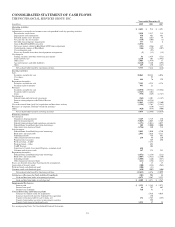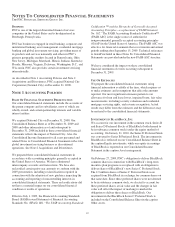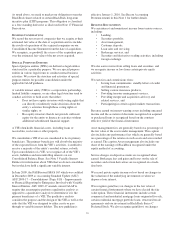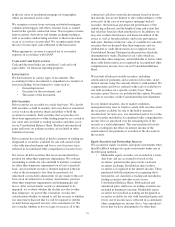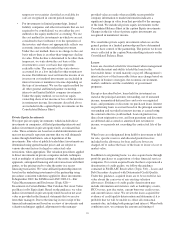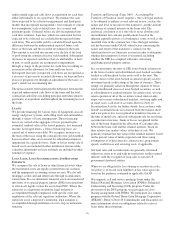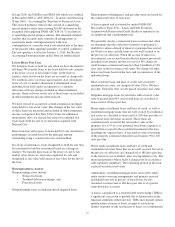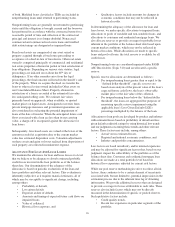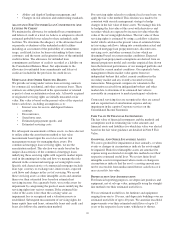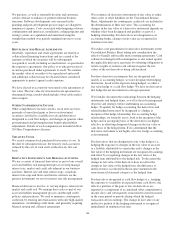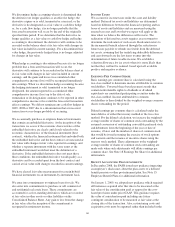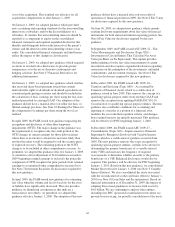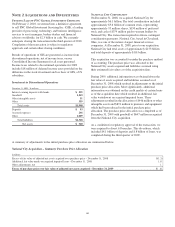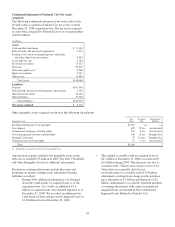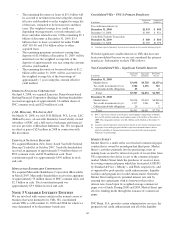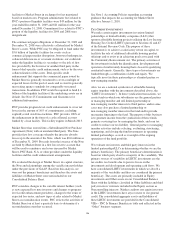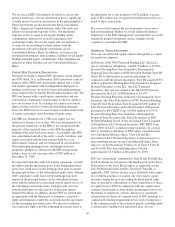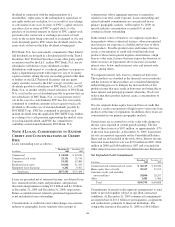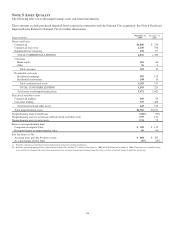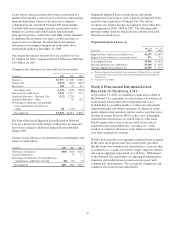PNC Bank 2009 Annual Report Download - page 105
Download and view the complete annual report
Please find page 105 of the 2009 PNC Bank annual report below. You can navigate through the pages in the report by either clicking on the pages listed below, or by using the keyword search tool below to find specific information within the annual report.We discontinue hedge accounting when it is determined that
the derivative no longer qualifies as an effective hedge; the
derivative expires or is sold, terminated or exercised; or the
derivative is de-designated as a fair value or cash flow hedge
or, for a cash flow hedge, it is no longer probable that the
forecasted transaction will occur by the end of the originally
specified time period. If we determine that the derivative no
longer qualifies as a fair value or cash flow hedge and hedge
accounting is discontinued, the derivative will continue to be
recorded on the balance sheet at its fair value with changes in
fair value included in current earnings. For a discontinued fair
value hedge, the previously hedged item is no longer adjusted
for changes in fair value.
When hedge accounting is discontinued because it is no longer
probable that a forecasted transaction will occur, the
derivative will continue to be recorded on the balance sheet at
its fair value with changes in fair value included in current
earnings, and the gains and losses in accumulated other
comprehensive income (loss) will be recognized immediately
into earnings. When we discontinue hedge accounting because
the hedging instrument is sold, terminated or no longer
designated, the amount reported in accumulated other
comprehensive income (loss) up to the date of sale,
termination or de-designation continues to be reported in other
comprehensive income or loss until the forecasted transaction
affects earnings. We did not terminate any cash flow hedges in
2009, 2008 or 2007 due to a determination that a forecasted
transaction was no longer probable of occurring.
We occasionally purchase or originate financial instruments
that contain an embedded derivative. At the inception of the
transaction, we assess if the economic characteristics of the
embedded derivative are clearly and closely related to the
economic characteristics of the financial instrument (host
contract), whether the financial instrument that embodied both
the embedded derivative and the host contract are measured at
fair value with changes in fair value reported in earnings, and
whether a separate instrument with the same terms as the
embedded instrument would not meet the definition of a
derivative. If the embedded derivative does not meet these
three conditions, the embedded derivative would qualify as a
derivative and be recorded apart from the host contract and
carried at fair value with changes recorded in current earnings.
We have elected fair value measurement for certain hybrid
financial instruments on an instrument-by-instrument basis.
We enter into commitments to originate loans for sale. We
also enter into commitments to purchase or sell commercial
and residential real estate loans. These commitments are
accounted for as free-standing derivatives which are recorded
at fair value in other assets or other liabilities on the
Consolidated Balance Sheet. Any gain or loss from the change
in fair value after the inception of the commitment is
recognized in noninterest income.
I
NCOME
T
AXES
We account for income taxes under the asset and liability
method. Deferred tax assets and liabilities are determined
based on differences between the financial reporting and tax
bases of assets and liabilities and are measured using the
enacted tax rates and laws that we expect will apply at the
time when we believe the differences will reverse. The
realization of deferred tax assets requires an assessment to
determine the realization of such assets. Realization refers to
the incremental benefit achieved through the reduction in
future taxes payable or refunds receivable from the deferred
tax assets, assuming that the underlying deductible differences
and carryforwards are the last items to enter into the
determination of future taxable income. We establish a
valuation allowance for tax assets when it is more likely than
not that they will not be realized, based upon all available
positive and negative evidence.
E
ARNINGS
P
ER
C
OMMON
S
HARE
Basic earnings per common share is calculated using the
two-class method to determine income attributable to common
stockholders. Unvested share-based payment awards that
contain nonforfeitable rights to dividends or dividend
equivalents are considered participating securities under the
two-class method. Income attributable to common
stockholders is then divided by the weighted-average common
shares outstanding for the period.
Diluted earnings per common share is calculated under the
more dilutive of either the treasury method or the two-class
method. For the diluted calculation, we increase the weighted-
average number of shares of common stock outstanding by the
assumed conversion of outstanding convertible preferred stock
and debentures from the beginning of the year or date of
issuance, if later, and the number of shares of common stock
that would be issued assuming the exercise of stock options
and warrants and the issuance of incentive shares using the
treasury stock method. These adjustments to the weighted-
average number of shares of common stock outstanding are
made only when such adjustments will dilute earnings per
common share. See Note 18 Earnings Per Share for additional
information.
R
ECENT
A
CCOUNTING
P
RONOUNCEMENTS
In December 2008, the FASB issued new guidance impacting
an employer’s disclosures about the plan assets of a defined
benefit pension or other postretirement plan. See Note 15
Employee Benefit Plans for additional information.
On January 1, 2009, we adopted new guidance which required
all businesses acquired after that date to be measured at the
fair value of the consideration paid as opposed to the cost-
based provisions under prior GAAP. This guidance requires
the value of consideration paid including any future
contingent consideration to be measured at fair value at the
closing date of the transaction. Also, restructuring costs and
acquisition costs must be expensed rather than included in the
101


